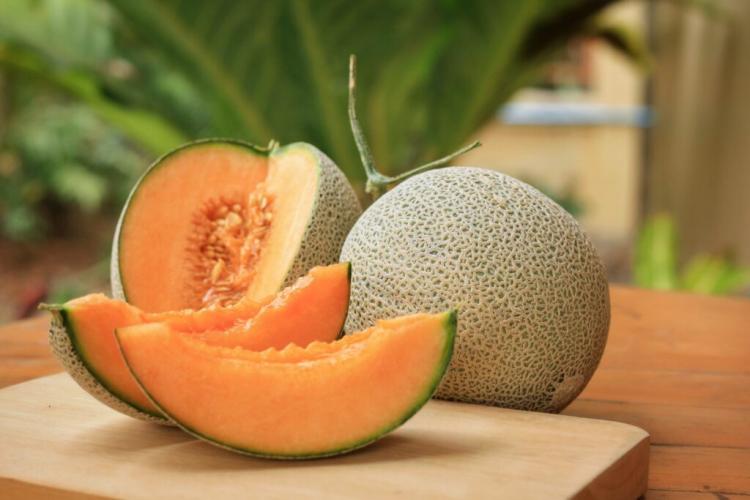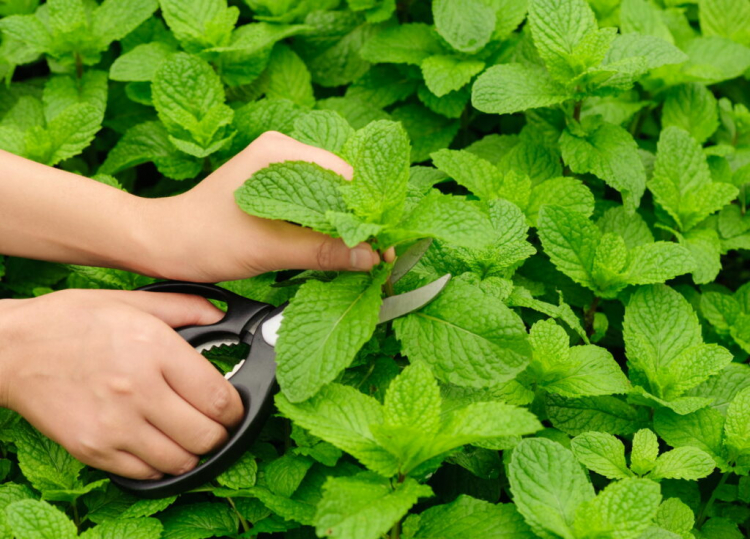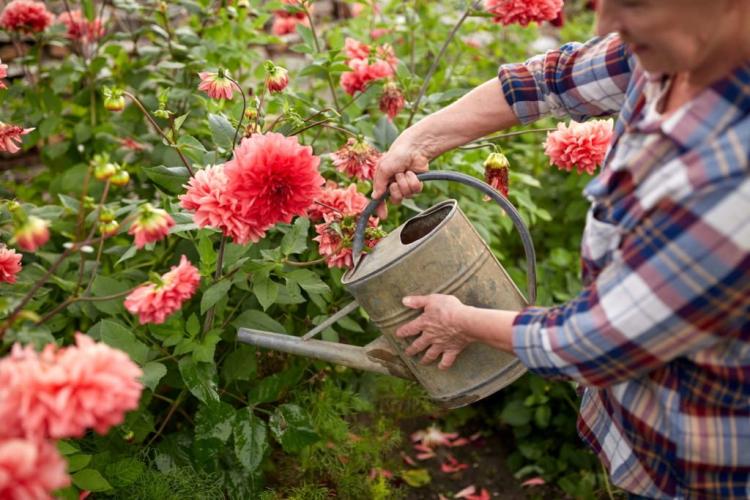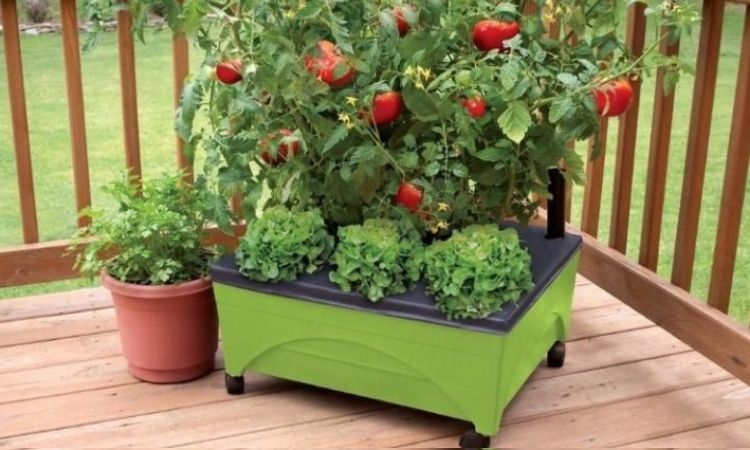Cantaloupe Melon: Everything You Need To Plant And Care For The Sugar Melon
The popular sugar melon can also be grown here. We show you what to look for when planting and caring for cantaloupe melons.
Cantaloupe melons ( Cucumis melo var. Cantalupensis ) belong to the group of sugar melons. Their sweet, orange pulp is reminiscent of summer, vacation, and sun. If you want to bring this feeling of summer into your garden, you can also grow the melon yourself. In our article, we’ll tell you what you need to know about growing cantaloupe melons. Here you will find everything about the origin, popular varieties, planting, care, and harvesting of the delicious melon.
The cantaloupe melon is a variety of the sugar melon ( Cucumis melo L.) and belongs to the genus of cucumbers ( Cucumis ). Pumpkin (Cucurbita ) and cucumber also belong to the same genus ( Cucumis sativus ) and zucchini ( Cucurbita pepo subsp. Pepo convar. Giromontiina ). Therefore, contrary to popular belief, it is officially a vegetable and not a fruit, although it is used as such in the kitchen and also in trade.
Other names for cantaloupe are wart melon or sugar melon. The name of the wart melon, which doesn’t sound quite so nice, is due to the exterior of the melon. The light to dark green skin of the delicious fruit is crisscrossed with many furrows; for many, these look like warts. Even if the shell of the melon seems wrinkled and unattractive, there is a real treasure inside: The orange pulp is aromatic, sweet, and is also full of vitamins, fiber, and beta-carotene.
Origin and characteristics of the cantaloupe melon
Table of Contents
The cantaloupe is originally from Iran. It was grown there around 5000 years ago. 1000 years later it reached the eastern Mediterranean, Greece, and Egypt. According to legend, in 1700 AD the cantaloupe melon was first grown and planted from seed in Cantaloupe in Sabina (Italy) on papal soil. Hence the melon got its name. Today the delicious fruit is mainly grown in Asia, but also in Spain, Italy, and France. Even in the USA, the cantaloupe is cultivated in areas with a mild climate, especially in wine-growing areas, in the summer months.
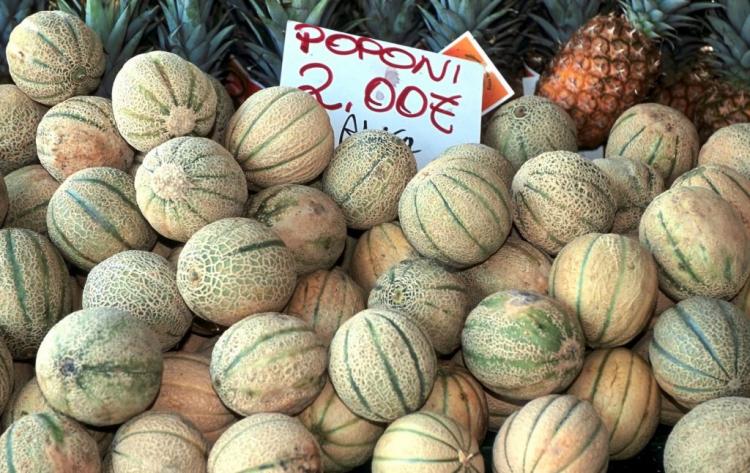
The cantaloupe is annual and has long, creeping, and climbing shoots. Dark green, hairy leaves that can be almost prickly sit on the shoots. Only the female flowers produce fruits. The male flowers shine in a striking yellow color, but do not produce melons. The fruits themselves can weigh 0.5 to 1.5 kilograms and have yellowish to light green skin that is covered with a kind of scab. Inside the melon, there is soft, orange pulp and in the middle, there are numerous, medium-sized kernels.
The most popular varieties of cantaloupe melon
The cantaloupe can look back on a long time as a useful plant. Accordingly, there are many different breeds and varieties around the world. The choice of variety determines, among other things, the size and shelf life of the melon. We have put together some interesting varieties for you below.
Popular varieties of cantaloupe melon:
- ˈCharentaisˈ: The variety makes round, small fruits with an intense aromatic taste. The melons can weigh between 0.5 and 1.5 kilograms.
- ˈInfinite Goldˈ: This variety is characterized by its long shelf life after harvest. The taste is less aromatic and intense.
- ˈStreits Freiland Grünnetetztˈ: This variety is particularly suitable for cultivation in our latitudes. It forms rather small, but aromatic fruits.
- ˈEden’s Gemˈ: Although this variety is very heavily wetted on the outside, it forms fruits weighing around 1 kilogram.
- ˈDelicious from Pilnitzˈ: Rather unsuitable for outdoors, this variety is more suitable for the greenhouse. In particularly warm areas, however, it can also be grown outside.
- ˈSarah’s Choiceˈ: This variety is also very well adapted to outdoor cultivation and produces fruits weighing up to 1.5 kilograms.
- ˈMurrmelˈ: This variety was bred in Baden-Württemberg and therefore fits perfectly in home gardens. The pulp tastes very aromatic and sweet.
- ˈHale’s Bestˈ: This old variety can even produce melons weighing 3 kilograms. The fruits also taste very sweet and intense.
- ˈBari F1ˈ: This variety is very productive, the fruits are tasty and aromatic.
Buying a cantaloupe melon: what to consider
When buying cantaloupe melons, you can choose between pre-grown young plants or seeds. Of course, preferring the melon plants always involves a certain risk and involves work. Young plants that have already been grown on the market are considerably more expensive than seeds but have the advantage that they are often refined and therefore more resistant than self-grown plants.
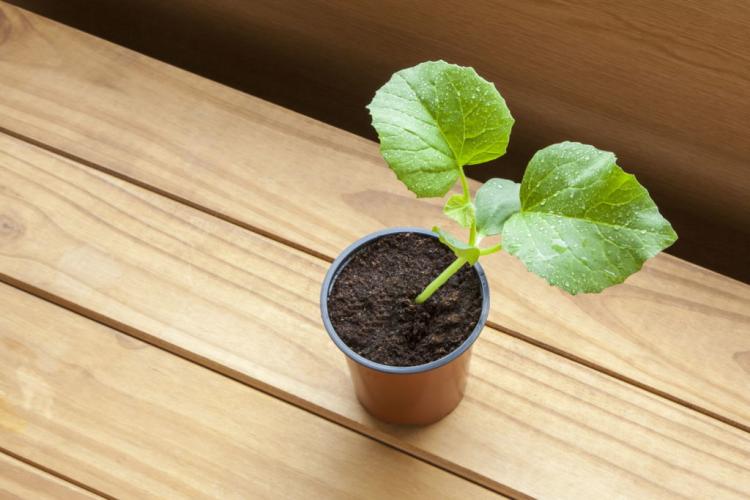
If you decide to buy cantaloupe plants, you can find them in spring in hardware stores, garden centers, weekly markets, or on the Internet. When buying, first of all, pay attention to the choice of the variety. This should be as suitable as possible to the location conditions in your garden. In addition, you should only acquire healthy and vigorous young plants. Make sure that the leaves and shoots of the plant are undamaged. There should also be no signs of feeding or other signs of diseases or pests. The root ball should not smell rotten, but fresh and earthy.
What should you look for when buying cantaloupe melons?
- Variety choice
- Strong plant
- Undamaged leaves and shoots
- Disease and pest free
- No putrid smell
Plant the cantaloupe
So that the delicious melons can also thrive in your garden, they must of course be planted there. In the next few sections, you will learn everything about the right time to plant, the best location for the cantaloupe, and the planting procedure.
When will the cantaloupe melons be planted?
Melons originally come from more southerly regions and cannot do anything with too cold weather. It is therefore advisable to prefer melon plants indoors and then plant them out. The ideal time to do this is four to six weeks before planting outdoors. The cantaloupe melons can only be put into the greenhouse when there is definitely no more frost to be expected – that is best after the ice saints, i.e. mid-May. You can therefore prefer the young plants from the end of March to the beginning/middle of April. The melons should not be put outdoors until the beginning of June. Then they will find the ideal conditions to grow there too.
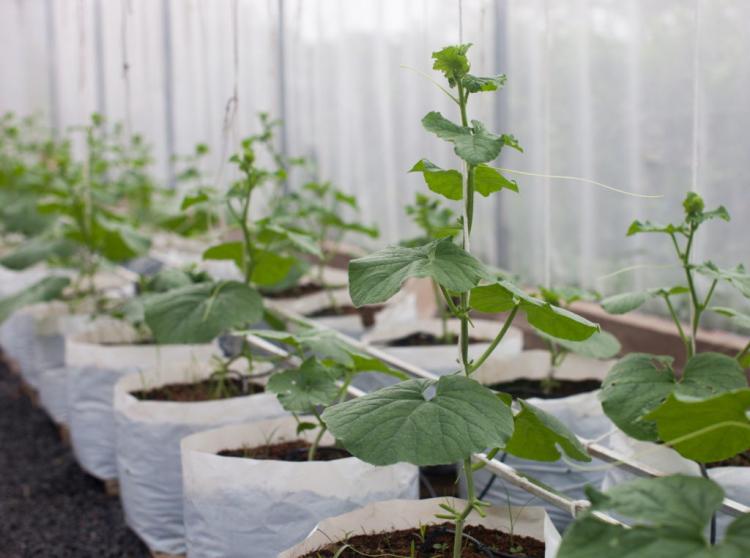
The ideal time to plant cantaloupe melons:
- Prefer 4-6 weeks before planting out
- Sow from late March to mid-April
- Plant out in the greenhouse: From mid-May
- Plant out in the open: from the beginning of June
The perfect location for cantaloupe melons
For the cantaloupe to find the best conditions to grow in your garden, you should choose the location and soil for your melon carefully. Above all, the melons need a lot of space to grow. Therefore, choose a sufficiently large bed in the garden or the greenhouse. In full splendor, the cantaloupe melons can take up to four square meters per plant. A sheltered location is also important. The small young plants cannot tolerate full sun and should therefore be in partial shade.
Too much light, especially at lunchtime, can cause burns on the leaves, which are still tender. Make sure you have enough shade – you can also use a sun protection film to help. If the melons are already bigger, they won’t mind the blazing midday sun. Warmth is then particularly important for maturing, so temperatures should never be below 12 ° C for waxing. Temperatures between 25 and 35 ° C are ideal in summer. The temperature of the soil also plays a role in the melon thriving. This is ideally between 20 and 25 ° C. A black foil over the floor, which warms up better, can help.
What is the perfect location for cantaloupe melons?
- As much space as possible
- Sheltered from the wind
- Shade young plants
- The temperature of at least 12 ° C
- Ideal temperatures in summer: 25 – 35 ° C
- Ideal floor temperature: 20 – 25 ° C
The ideal base for cantaloupe melons
Of course, the soil also plays an important role in the success of melon cultivation, so it should be prepared in good time. The melon absolutely does not tolerate waterlogging and therefore likes loose, well-drained soil. Soil that is too firm and wet can be enriched with mineral material such as sand before planting. The ideal pH value for the cantaloupe is 5.5 to 7. So sugar melons tolerate acidic soils.
Our peat-free Gardender organic universal soil is ideal for this, for example. In addition, the soil should be as rich in nutrients as possible. If this is not the case with your substrate, it is best to work a fertilizer with an organic long-term effect into the soil before planting. This ensures that the melon has enough nutrients available right from the start. Alternatively, you can use compost or well-rotted manure.
What is the ideal base for cantaloupe melons?
- Loose and permeable
- No waterlogging
- Nutrient-rich
- pH value: 5.5 – 7
Prefer cantaloupe melons
If you prefer, prepare small pots with potting soil. Here you always place three seeds one to two centimeters deep in the soil and press them in lightly. Then it is poured on well. The seedlings feel particularly comfortable in a bright and warm location, for example on the windowsill above the heater. Optimal conditions for cultivation exist in a self-made mini greenhouse.
Otherwise, you can also put plastic bags over the potty and regularly provide sufficient moisture with a spray bottle. At temperatures between 25 and 30 ° C, the seeds do not begin to grow in a few days. If two cotyledons can be seen on the seedlings, they can be carefully pricked out. To do this, select the strongest seedlings and separate them so that there is only one seedling in each potty. Now the plants can stand without a cover. Even so, they are not yet ready for the field, as they can only be planted outside four to six weeks after sowing.
How do you prefer cantaloupe melons?
- Prepare pots with potting soil
- Sowing depth: 1 – 2 cm
- Always sow 3 seeds together
- Cover with a plastic bag or put in the mini greenhouse
- Make sure there is sufficient moisture
- Germination temperature: 25 – 30 ° C
- Germination time: a few days
- Prick out at the dicotyledon stage
- After that, no more cover is needed
- Plant out after 4 – 6 weeks
Plant out the cantaloupe melons
As soon as it is warm enough outside or in the greenhouse, the pre-grown or purchased plants can be planted out. Prepare the bed by loosening it thoroughly and incorporating organic material such as compost, well-rotted manure, or a fertilizer with long-term organic effects. Our Gardender organic universal fertilizer is well suited for the cantaloupe melon, as it supplies the plant with sufficient nutrients and is also kind to the environment. The melons grow ideally on small planting mounds that should be about the size of an A4 sheet of paper and a hand’s breadth high.
Leave enough space between each hill, at least 1.5 meters. Now dig a small hole in the middle of the plant mound and place the plants in it. However, they should not be used any deeper than they were in the pot. Finally, the plants are well watered and, if necessary, shading is installed. So that the soil can warm up well, a black film or a thick layer of dark compost as mulch will help.
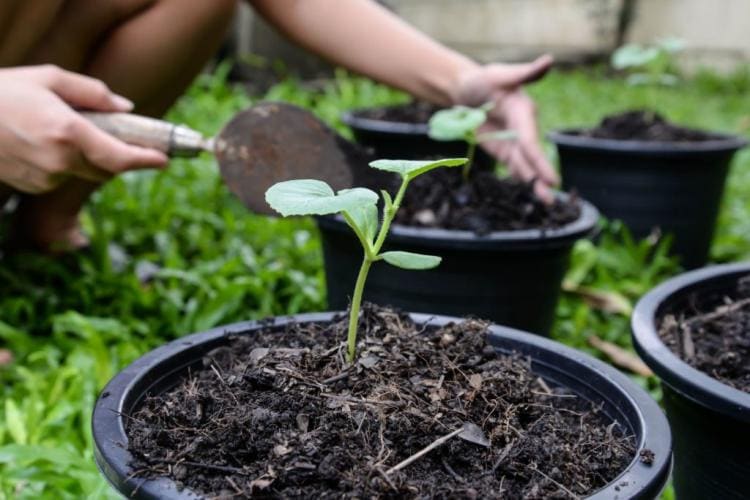
Step-by-step instructions: Plant out the cantaloupe melons
- Loosen up the bed well
- Work organic material into the soil
- Create planting mound
- Dig a small hole in the middle of the hill
- Insert young plants
- Water well
- Shade young plants if necessary
- Layout black sheeting or mulch with a thick layer of compost
Caring for cantaloupe melons
Even after planting, the work on the cantaloupe is not done, because it needs regular care to be able to delight you with beautiful fruits. Melons need sufficient water, especially on hot and sunny days. It is best to water in the evening so as not to burn the leaves. As soon as the plant has produced fruit, the watering can be reduced. Too much water damages the delicious fruits dilutes the sugar content and dilutes the taste.
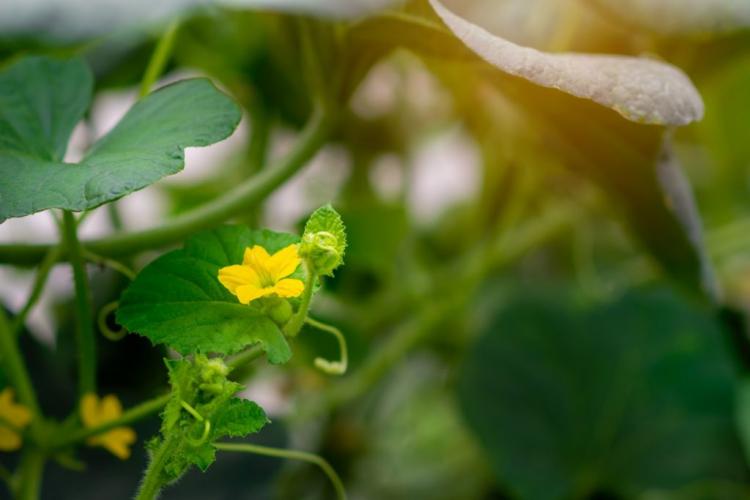
If you have already applied fertilizer in the form of compost or fertilizer with organic long-term effects when planting, the next fertilization is only necessary when the plant forms flowers. Then she is happy to receive another fertilizer with sufficient nitrogen, phosphorus, and potassium. You will find the ideal composition of nutrients in our Gardender organic universal fertilizer with organic long-term effects. After the flowering period, another fertilization after eight weeks is advisable. Alternatively, you can also use mineral fertilizer. However, this should be applied at shorter intervals, every four to six weeks.
How are cantaloupe melons cared for?
- Water regularly and sufficiently
- Avoid waterlogging
- Reduce watering after fruit formation
- Fertilize regularly as soon as flowers have formed
- remove weeds
Propagate cantaloupe melons
If you don’t want to buy new seeds every year, you can also get seeds from your own melons as long as they don’t come from hybrid seeds. To do this, remove the seeds from the harvested melon and free them from the pulp. The seeds are then soaked in cold water for two days and then spread out on a paper towel to dry. As soon as the seeds are completely dry, they can be stored in a dry, dark, and cool place until the next year or the year after.
How are cantaloupe melons propagated?
- Remove seeds from harvested melon
- Remove the pulp
- Soak in water for 2 days
- Let dry completely on a paper towel
- Store in a dry, cool, and dark place
- Seeds can be kept for up to 2 years
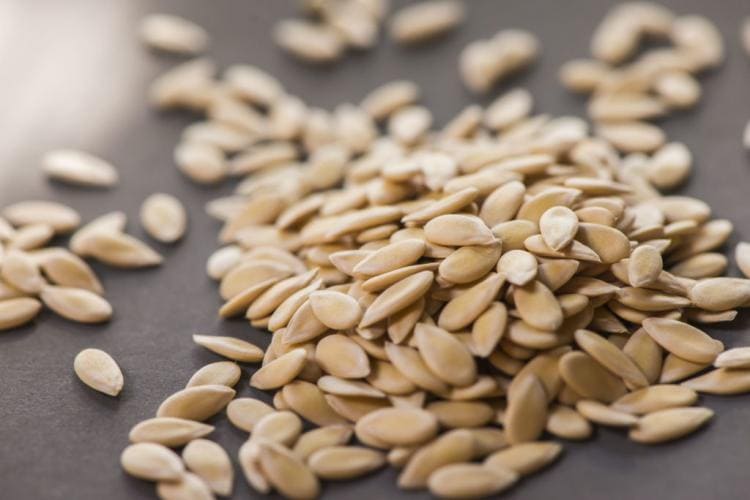
Harvest and store cantaloupe melons
It is not easy to find the right time to harvest the cantaloupe. But three clear signs indicate the correct ripeness of the melon.
When is the cantaloupe ripe?
- The stem breaks easily.
- The fruit gives off an intense, sweet fragrance.
- The skin is light green to slightly yellow in color.
Melons grow very quickly and are usually ripe within four weeks. If the melons were planted in the garden bed in June, you can probably harvest the first fruits as early as late July to early August. Use a sharp knife for this and cut through the stem of the melon. Overripe melons fall off the stalk all by themselves. If the melons are completely yellow, they are overripe. The sad news is that the cantaloupe cannot be stored for very long. As a whole, it can only be stored for a maximum of three weeks after harvesting at an ideal 3 to 5 ° C. A cantaloupe melon that has already been cut is best stored in the refrigerator and will use up within two to three days.
Harvesting and storing cantaloupe melon:
- Harvest begins at the end of July
- Cut the handle with a knife
- Storage temperature: 3 – 5 ° C
- Whole fruits can be kept for up to 3 weeks
- Consume cut fruits in the refrigerator within 2 to 3 days
Calories and vitamins of the cantaloupe melon
Cantaloupe melons are said to be particularly healthy: They are said to ensure a strong immune system, as well as shiny hair and good eyes. Due to its high water content, this melon also has very few calories, making it the perfect snack for hot summer days. In addition to water, the cantaloupe has other valuable ingredients.
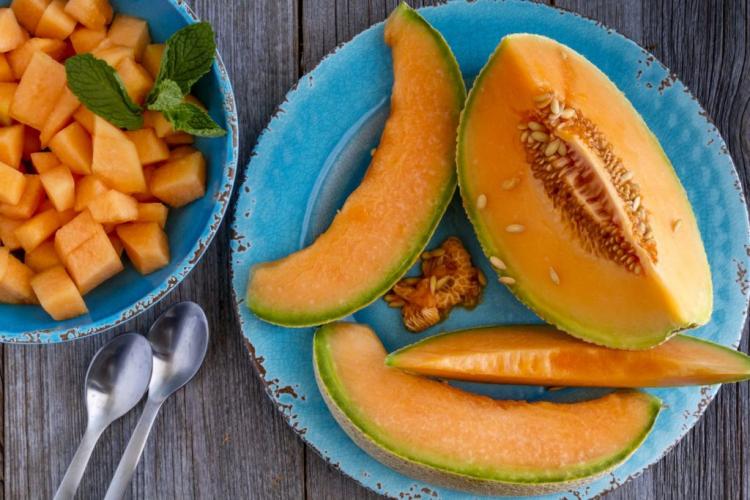
100 grams of fresh cantaloupe contain:
- 10 kcal
- 7.86 g of sugar
- 0.9 g fiber
- 0.19 g fat
- 1.84 g protein
- 90.15 g of water
- 9 mg calcium
- 12 mg of magnesium
- 15 mg of phosphorus
The cantaloupe also contains plenty of vitamin C and a lot of beta-carotene. This can be converted by the body into vitamin A, which, for example, strengthens the immune system.
For eating, the melon is divided in the middle and the seeds are easily removed from the middle with a spoon. The fruit is now ready to be eaten and can be prepared in a variety of ways. In summer the melon tastes wonderfully refreshing when it comes out of the fridge cold. It is also delicious in salads or a punch. Another option is the Italian classic with ham. Or try a cold soup made from the cantaloupe melon in summer.

You might so like:
